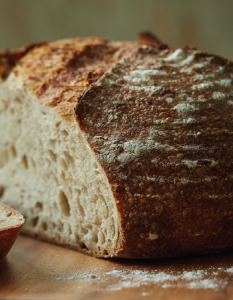When it co mes to food storage, putting your groceries away in the refrigerator may seem like a no brainer. Items such as fruits, vegetables, dairy products, and meat experience greatly heightened levels of longevity when kept in these cool spaces. Since the fridge is such a great spot to preserve edibles in order to make them last longer, then obviously it is a great place to keep bread, right? Wrong.
mes to food storage, putting your groceries away in the refrigerator may seem like a no brainer. Items such as fruits, vegetables, dairy products, and meat experience greatly heightened levels of longevity when kept in these cool spaces. Since the fridge is such a great spot to preserve edibles in order to make them last longer, then obviously it is a great place to keep bread, right? Wrong.
In reality, storing bread in the refrigerator can actually cause it to go stale much faster than simply keeping it at a cozy room temperature. At A Bread Affair, we strive to craft baked goods that will delight your senses in every way, and therefore only want to provide you, dear reader, with the most sound advice on how to make sure that your bread remains as fresh as possible. Whether it has been purchased from our store on Granville Island or a booth at the Farmer’s market, or from the supermarket, it doesn’t matter: what matters is that we, the bread experts, can impart knowledge onto you regarding the best ways to maximize your dining experience. Now before we get into our bread storage tips, let us just say that the best storage is to not store at all, but rather to eat in one sitting…and with that, here are four handy tips on how to properly store your bread:
-
Wrap It Up: Although the standard paper bag is certainly the most classic, and perhaps visually appealing, method of bread storage, try using plastic or aluminum foil instead. Most store-bought bread already comes in a convenient plastic wrap of some kind, which, when properly sealed, will retain moisture in order to prevent the onset of staleness. Unless you plan on chowing down on your tasty loaf within the next few hours, it’s probably time to upgrade to something a bit sturdier than paper.
-
Time and Temperature is Everything: Room temperature, which rests around 20 degrees Celsius, is definitely the preferred heat to keep bread at its freshest. As long as it out of direct sunlight and in a relatively dry place, then this should keep it fresh for approximately two days. After that…
-
Freeze!: Freezing the bread just before staleness sets in is certainly the most optimal way to ensure that it keeps its flavor and texture upon thawing. According to science, it stops the starch in the bread from recrystallizing, therefore alleviating that tough, unpleasant sensation that signifies your loaf is toast (but not in a good way). Unless you have a hacksaw handy, slicing your bread before freezing is always a good idea too.
-
PPTT: Practice Proper Thawing Techniques: The best ways to thaw bread once it has been frozen are to either allow it to thaw at room temperature, or toss it in the oven or toaster for a few minutes. No matter which method you choose, always remember that once it has been heated once, your slices will never be in the proper state to freeze or re-heat, as it will have already reached it’s threshold of staleness.
 Now, may stale bread never inconvenience you again! Okay, it still might be a possibility, but at least by following these basic tips (even used by professionals such as ourselves), you can make sure that your baked goods keep for a long time. Either way, if you happen to stumble upon our bakery, you needn’t worry about us following these as all of our items are made fresh every morning with only the best organic artisanal ingredients! See you soon!
Now, may stale bread never inconvenience you again! Okay, it still might be a possibility, but at least by following these basic tips (even used by professionals such as ourselves), you can make sure that your baked goods keep for a long time. Either way, if you happen to stumble upon our bakery, you needn’t worry about us following these as all of our items are made fresh every morning with only the best organic artisanal ingredients! See you soon!